#ram janmabhoomi verdict
Explore tagged Tumblr posts
Text
“Ram Mandir Ayodhya”
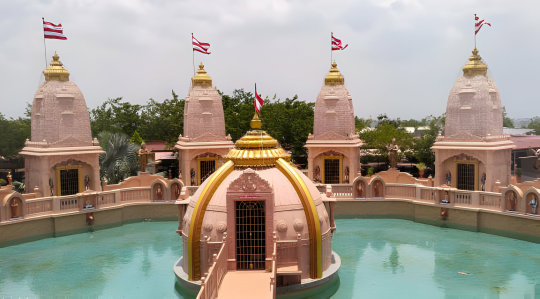
Let's talk about the beauty of India – “Ram Mandir Ayodhya”.
The story of Ram Mandir dates back to ancient times when Ayodhya was the capital of the mighty kingdom of Kosala. The revered epic, Ramayana, chronicles Rama's life, his exile, and the triumph of good over evil in the form of the demon king Ravana. Ram Mandir - the living testament to the confluence of history, devotion, and the collective heartbeat of a nation. This sacred sanctuary, arising from the dust of centuries, is not just a place of worship but a symphony of stories etched into the very soul of India. The journey towards the construction of this magnificent temple is woven into the very fabric of India's rich cultural tapestry, blending history, religion, and the collective consciousness of millions.
"The Melody of Ages: Echoes of Timeless Tales within the Sacred Halls of the Ram Mandir Ayodhya"
Travel back in time to the days of the illustrious Kosala kingdom, with Ayodhya as its pulsating heart. Here, the epic of Lord Rama unfolded, a saga written across the skies and etched into the very earth upon which the Ram Mandir now stands. The Ramayana, that timeless scripture, narrates the divine odyssey of Rama, his trials, and the eventual triumph of virtue over vice. Ayodhya's spiritual gravity, rooted in the belief that the temple site is the sacred birthplace of Lord Rama, has beckoned pilgrims and seekers for centuries. This hallowed ground, now adorned by the resplendent Ram Mandir, echoes with the footsteps of those who sought solace in the embrace of devotion. The significance of Ayodhya in the Ramayana laid the foundation for the belief that the very spot where the temple stands today is the birthplace of Lord Rama. Over the centuries, Ayodhya became a symbol of devotion for millions of Hindus worldwide, fostering a deep spiritual connection to the Ram Janmabhoomi.
"Endurance Through Time: Tracing the Centuries-Long Struggle Leading to the Ram Mandir Ayodhya"
The narrative of the Ram Janmabhoomi also carries the weight of centuries of struggle and disputes. The Babri Masjid, built in the 16th century, stood on the same site, leading to a complex and emotionally charged legal and social battle. Decades of legal wrangling reached a pivotal moment in 2019 when the Supreme Court rendered a verdict in favor of constructing the Ram Mandir, a decision that recognized the sentiments of millions and sought to heal historical wounds.
"Sculpting Divinity: Exploring the Architectural Marvels and Spiritual Essence of the Ram Mandir"
The Ram Mandir isn't just a temple; it's a masterpiece of architectural poetry. The design of the Ram Mandir is a harmonious blend of architectural brilliance and spiritual symbolism. Its three-storied splendor is a canvas painted with intricate carvings, soaring domes, and spires that seem to touch the heavens. The sanctum sanctorum cradles the divine family – Lord Rama, Sita, Lakshmana, and Hanuman – in an ethereal embrace. Wander through the temple complex, and you'll be mesmerized by sculptures breathing life into the Ramayana. Each intricately carved scene tells a story, inviting devotees and visitors to immerse themselves in the rich tapestry of Rama's journey. The temple complex also features captivating sculptures depicting scenes from the Ramayana, inviting devotees to relive the epic saga of Rama. The sacredness of the site is enhanced by the serene surroundings, creating a tranquil atmosphere conducive to prayer and contemplation.
"A Symbol of Unity: The Ram Mandir Ayodhya, Bridging Hearts and Faiths in a Tapestry of Harmony"
The construction of the Ram Mandir has been a unifying force for the nation, transcending religious and cultural boundaries. The Ram Mandir, rising from the heart of Ayodhya, is more than an architectural marvel – it is a beacon of unity. Its construction serves as a reminder that within the varied threads of India's cultural fabric, there exists a harmonious tapestry. It exemplifies the spirit of inclusivity, fostering a sense of belonging for people of all faiths. The dedication of the temple to the ideals of Lord Rama, such as righteousness, justice, and compassion, sends a powerful message of unity in diversity. The temple transcends religious boundaries, inviting people from all walks of life to partake in the divine aura that permeates the air. The Ram Mandir Ayodhya stands as a testament to the enduring power of faith, the resilience of a nation, and the ability to overcome centuries of challenges. As pilgrims and wanderers alike embark on a pilgrimage to Ayodhya, they are greeted not just by stone and mortar but by the living essence of the Ram Mandir. It is not merely a structure of stone and mortar; it is a living embodiment of the values that have shaped the cultural landscape of India for millennia. It is a sanctuary where the past dances with the present, where devotion intertwines with heritage, and where the melody of unity resonates through the ages. In the shadows of this sacred abode, Ayodhya continues to weave its tales, inviting all to be a part of its eternal narrative. As pilgrims and tourists alike flock to Ayodhya to witness this architectural marvel, they partake in a journey through history, mythology, and the unwavering spirit of devotion that defines the essence of the Ram Mandir.
Now let's talk about the spritual date for all Hindus! and Ram Bhakts 22nd January 2024
"The Unveiling of Ram Mandir Ayodhya on January 22nd, 2024"
First let me tell you something is that we are the luckiest generation that we are witnessing many years struggle of our ancestors coming to end. 22nd January 2024 is a memorable day for everyone. On the auspicious day of January 22, 2024, the spiritual landscape of Ayodhya witnessed a historic moment that reverberated through the hearts of millions – the grand opening of the Ram Mandir. After decades of legal and societal debates, the culmination of the construction process marked a significant milestone in the religious and cultural history of India. Devotees, dignitaries, and people from all walks of life gathered in Ayodhya to witness the inauguration ceremony. The air was thick with anticipation and reverence as the doors of the Ram Mandir swung open, revealing a breathtaking architectural marvel. The three-storied structure, adorned with intricate carvings and symbolic representations from the Ramayana, stood as a testament to both faith and craftsmanship.
The sanctum sanctorum, the heart of the temple, housed the divine idols of Lord Rama, Goddess Sita, Lakshmana, and Hanuman. Pilgrims and visitors alike marveled at the spiritual aura enveloping the sacred space, where centuries of devotion found a tangible expression.
The opening of the Ram Mandir was not merely a religious event; it was a moment of unity and harmony. People from diverse backgrounds came together to celebrate the cultural heritage woven into the very fabric of Ayodhya. The resonance of hymns and prayers echoed through the city, carrying with them the hopes and aspirations of a nation united in reverence for Lord Rama.
17 notes
·
View notes
Text
[ad_1] Paromita Das GG News Bureau New Delhi, 6th December- The demolition of the Babri Masjid on December 6, 1992, marked a defining moment in Bharat’s political and cultural history. What began as a legal and historical dispute evolved into one of the most significant socio-religious movements in post-independence Bharat. This moment not only reshaped the political landscape but also symbolized a centuries-old struggle of Hindus to reclaim what they believed to be the birthplace of Lord Ram. The journey from the demolition to the Supreme Court’s verdict in 2019, and finally the grand consecration ceremony of the Ram Mandir in January 2024, captures the resilience of a movement and the lasting implications for Bharatiya society. The History of the Babri Masjid and the Dispute The Babri Masjid, built in 1528 by Mir Baqi, a commander of Mughal emperor Babur, stood on a site that Hindus believed to be the birthplace of Lord Ram. For centuries, this belief remained at the heart of local folklore and devotion. Tensions over the site date back to the colonial era, with legal petitions and confrontations as early as the 19th century. The turning point came in 1949, when an idol of Lord Ram was controversially placed inside the mosque. This event intensified the dispute, with both Hindus and Muslims claiming the site as their own. The government declared the site disputed and locked it, allowing only limited access for worship. The legal battle that ensued set the stage for decades of political and communal tension. The Babri Masjid Demolition: December 6, 1992 The demolition of the Babri Masjid was the culmination of the Ram Janmabhoomi movement, led by the Vishva Hindu Parishad (VHP) and supported by the Bharatiya Janata Party (BJP). The movement aimed to build a grand Ram temple at the site, asserting that the mosque had been built over an ancient Hindu temple. On December 6, 1992, despite assurances by the movement’s leaders to the Supreme Court that the mosque would not be harmed, a large mob of kar sevaks demolished the structure. This act triggered nationwide communal riots, resulting in significant loss of life and property. The demolition remains one of the most polarizing events in Bharat’s history, shaping the trajectory of the nation’s politics and social fabric for decades. The Struggle for Ram Mandir: A Symbol of Hindu Resurgence The demolition of the Babri Masjid galvanized the Hindu nationalist movement, transforming the demand for a Ram temple into a powerful political and cultural issue. The BJP, led by leaders like L.K. Advani, capitalized on the movement, undertaking initiatives such as the Rath Yatra in 1990, which aimed to mobilize support for the temple’s construction. The Ram Janmabhoomi movement became a symbol of Hindu identity and resurgence, uniting millions of Hindus across caste and regional lines. The slogan “Mandir Wahin Banayenge” (The temple will be built there) echoed across the nation, solidifying the BJP’s position as a major political force. By the mid-1990s, the BJP had emerged as a dominant party in Bharatiya politics, largely on the back of the Ram Mandir issue. Despite the political momentum, the movement faced significant legal and administrative hurdles. Successive governments grappled with balancing religious sentiments and constitutional secularism, prolonging the resolution of the dispute. The Supreme Court Verdict: November 9, 2019 After decades of legal battles and political negotiations, the Supreme Court of India delivered its landmark verdict on November 9, 2019. The court unanimously ruled in favor of the Hindu claimants, granting them the disputed land for the construction of a Ram temple. The judgment acknowledged the faith of millions of Hindus while also emphasizing the importance of maintaining communal harmony. To address the concerns of the Muslim community, the court directed the government to allocate a separate five-acre plot in Ayodhya for the construction of a mosque. This balanced approach sought to bring closure to a dispute that had deeply divided the nation.
The verdict was widely celebrated by Hindus as the culmination of their struggle for the Ram Janmabhoomi. For the BJP, which had made the temple issue a cornerstone of its political identity, the judgment was a significant victory. Construction of the Ram Mandir: A Grand Vision Realized The construction of the Ram Mandir began soon after the Supreme Court verdict. The Shri Ram Janmabhoomi Teerth Kshetra Trust was established to oversee the temple’s construction, ensuring transparency and public involvement. The foundation stone was laid by Prime Minister Narendra Modi on August 5, 2020, in a ceremony that highlighted the temple’s significance as a cultural and spiritual milestone for Hindus. The temple, designed to be one of the largest and most magnificent in Bharat, symbolizes not just religious devotion but also the fulfillment of a historical and cultural aspiration. The construction process involved meticulous planning and collaboration among architects, historians, and religious scholars to ensure authenticity and grandeur. In January 2024, the nation witnessed the grand consecration ceremony of the temple. Prime Minister Modi, along with religious and political leaders, participated in the event, which was attended by devotees from across the country. The consecration marked the final chapter in a journey that had spanned centuries, transforming the disputed site into a symbol of unity and faith. The Legacy of the Babri Masjid Demolition and Ram Mandir The demolition of the Babri Masjid and the subsequent construction of the Ram Mandir represent a complex legacy. For many Hindus, the temple is a symbol of cultural resurgence and justice, reclaiming a sacred site that holds immense historical and spiritual significance. However, the events surrounding the demolition also underscore the challenges of balancing religious aspirations with communal harmony in a diverse nation like Bharat. The Ram Janmabhoomi movement reshaped Bharat’s political landscape, fueling the rise of the BJP and the consolidation of Hindu nationalism. At the same time, it deepened communal divisions, highlighting the need for dialogue and reconciliation. The Supreme Court’s verdict and the subsequent temple construction offer an opportunity for closure, but the journey to healing and unity remains ongoing. Conclusion: A New Chapter in Bharatiya History The story of the Babri Masjid demolition and the construction of the Ram Mandir is not just about a physical structure; it is a reflection of Bharat’s evolving identity. It captures the struggles and aspirations of a community, the complexities of a diverse society, and the resilience of a democratic system in resolving deeply rooted conflicts. As the Ram Mandir stands tall in Ayodhya, it is both a monument to faith and a reminder of the need for harmony in a pluralistic nation. The journey from demolition to construction has been long and fraught with challenges, but it also underscores the power of persistence and belief in shaping the course of history. The post From Rubble to Reverence: The 32-Year Saga of Babri Masjid and the Rise of Ram Mandir appeared first on Global Governance News- Asia's First Bilingual News portal for Global News and Updates. [ad_2] Source link
0 notes
Text
[ad_1] Paromita Das GG News Bureau New Delhi, 6th December- The demolition of the Babri Masjid on December 6, 1992, marked a defining moment in Bharat’s political and cultural history. What began as a legal and historical dispute evolved into one of the most significant socio-religious movements in post-independence Bharat. This moment not only reshaped the political landscape but also symbolized a centuries-old struggle of Hindus to reclaim what they believed to be the birthplace of Lord Ram. The journey from the demolition to the Supreme Court’s verdict in 2019, and finally the grand consecration ceremony of the Ram Mandir in January 2024, captures the resilience of a movement and the lasting implications for Bharatiya society. The History of the Babri Masjid and the Dispute The Babri Masjid, built in 1528 by Mir Baqi, a commander of Mughal emperor Babur, stood on a site that Hindus believed to be the birthplace of Lord Ram. For centuries, this belief remained at the heart of local folklore and devotion. Tensions over the site date back to the colonial era, with legal petitions and confrontations as early as the 19th century. The turning point came in 1949, when an idol of Lord Ram was controversially placed inside the mosque. This event intensified the dispute, with both Hindus and Muslims claiming the site as their own. The government declared the site disputed and locked it, allowing only limited access for worship. The legal battle that ensued set the stage for decades of political and communal tension. The Babri Masjid Demolition: December 6, 1992 The demolition of the Babri Masjid was the culmination of the Ram Janmabhoomi movement, led by the Vishva Hindu Parishad (VHP) and supported by the Bharatiya Janata Party (BJP). The movement aimed to build a grand Ram temple at the site, asserting that the mosque had been built over an ancient Hindu temple. On December 6, 1992, despite assurances by the movement’s leaders to the Supreme Court that the mosque would not be harmed, a large mob of kar sevaks demolished the structure. This act triggered nationwide communal riots, resulting in significant loss of life and property. The demolition remains one of the most polarizing events in Bharat’s history, shaping the trajectory of the nation’s politics and social fabric for decades. The Struggle for Ram Mandir: A Symbol of Hindu Resurgence The demolition of the Babri Masjid galvanized the Hindu nationalist movement, transforming the demand for a Ram temple into a powerful political and cultural issue. The BJP, led by leaders like L.K. Advani, capitalized on the movement, undertaking initiatives such as the Rath Yatra in 1990, which aimed to mobilize support for the temple’s construction. The Ram Janmabhoomi movement became a symbol of Hindu identity and resurgence, uniting millions of Hindus across caste and regional lines. The slogan “Mandir Wahin Banayenge” (The temple will be built there) echoed across the nation, solidifying the BJP’s position as a major political force. By the mid-1990s, the BJP had emerged as a dominant party in Bharatiya politics, largely on the back of the Ram Mandir issue. Despite the political momentum, the movement faced significant legal and administrative hurdles. Successive governments grappled with balancing religious sentiments and constitutional secularism, prolonging the resolution of the dispute. The Supreme Court Verdict: November 9, 2019 After decades of legal battles and political negotiations, the Supreme Court of India delivered its landmark verdict on November 9, 2019. The court unanimously ruled in favor of the Hindu claimants, granting them the disputed land for the construction of a Ram temple. The judgment acknowledged the faith of millions of Hindus while also emphasizing the importance of maintaining communal harmony. To address the concerns of the Muslim community, the court directed the government to allocate a separate five-acre plot in Ayodhya for the construction of a mosque. This balanced approach sought to bring closure to a dispute that had deeply divided the nation.
The verdict was widely celebrated by Hindus as the culmination of their struggle for the Ram Janmabhoomi. For the BJP, which had made the temple issue a cornerstone of its political identity, the judgment was a significant victory. Construction of the Ram Mandir: A Grand Vision Realized The construction of the Ram Mandir began soon after the Supreme Court verdict. The Shri Ram Janmabhoomi Teerth Kshetra Trust was established to oversee the temple’s construction, ensuring transparency and public involvement. The foundation stone was laid by Prime Minister Narendra Modi on August 5, 2020, in a ceremony that highlighted the temple’s significance as a cultural and spiritual milestone for Hindus. The temple, designed to be one of the largest and most magnificent in Bharat, symbolizes not just religious devotion but also the fulfillment of a historical and cultural aspiration. The construction process involved meticulous planning and collaboration among architects, historians, and religious scholars to ensure authenticity and grandeur. In January 2024, the nation witnessed the grand consecration ceremony of the temple. Prime Minister Modi, along with religious and political leaders, participated in the event, which was attended by devotees from across the country. The consecration marked the final chapter in a journey that had spanned centuries, transforming the disputed site into a symbol of unity and faith. The Legacy of the Babri Masjid Demolition and Ram Mandir The demolition of the Babri Masjid and the subsequent construction of the Ram Mandir represent a complex legacy. For many Hindus, the temple is a symbol of cultural resurgence and justice, reclaiming a sacred site that holds immense historical and spiritual significance. However, the events surrounding the demolition also underscore the challenges of balancing religious aspirations with communal harmony in a diverse nation like Bharat. The Ram Janmabhoomi movement reshaped Bharat’s political landscape, fueling the rise of the BJP and the consolidation of Hindu nationalism. At the same time, it deepened communal divisions, highlighting the need for dialogue and reconciliation. The Supreme Court’s verdict and the subsequent temple construction offer an opportunity for closure, but the journey to healing and unity remains ongoing. Conclusion: A New Chapter in Bharatiya History The story of the Babri Masjid demolition and the construction of the Ram Mandir is not just about a physical structure; it is a reflection of Bharat’s evolving identity. It captures the struggles and aspirations of a community, the complexities of a diverse society, and the resilience of a democratic system in resolving deeply rooted conflicts. As the Ram Mandir stands tall in Ayodhya, it is both a monument to faith and a reminder of the need for harmony in a pluralistic nation. The journey from demolition to construction has been long and fraught with challenges, but it also underscores the power of persistence and belief in shaping the course of history. The post From Rubble to Reverence: The 32-Year Saga of Babri Masjid and the Rise of Ram Mandir appeared first on Global Governance News- Asia's First Bilingual News portal for Global News and Updates. [ad_2] Source link
0 notes
Text
CJI Chandrachud Expresses Hope for Ayodhya Dispute Resolution Through Faith

Chief Justice of India DY Chandrachud shared his personal reflections on the long-standing Ram Janmabhoomi-Babri Masjid dispute, stating that he prayed to God for a resolution. Speaking at a ceremony in his native Kanhersar village, he emphasized the importance of faith, saying, “If you have faith, God will always find a way.”
Chandrachud recalled the challenges faced during the adjudication of the Ayodhya case, which he handled for three months. He mentioned that he prayed at the temple for divine guidance to resolve the matter. The CJI was part of the Supreme Court bench that delivered the landmark verdict on November 9, 2019, which allowed the construction of the Ram temple at the disputed site while also designating a five-acre alternative plot for a mosque in Ayodhya.
Chandrachud's comments come after his visit to the Ram Temple in July, where he offered prayers. The temple’s idol consecration ceremony was attended by Prime Minister Narendra Modi on January 22 of this year, marking a significant moment in the temple's construction.
#DYCChandrachud#ChiefJustice#IndianJudiciary#AyodhyaDispute#SupremeCourt#LegalReform#JudicialLeadership
0 notes
Text
Unveiling the Ayodhya Ram Mandir: A Complete Guide
The Ayodhya Ram Mandir, a partially constructed Hindu temple complex in Ayodhya, Uttar Pradesh, India, is a site of immense religious significance and historical intrigue. For centuries, it has been revered as the birthplace of Lord Rama, a central figure in the Hindu epic Ramayana. This guide delves into the Ayodhya Ram Mandir, offering a comprehensive overview of its history, architecture, religious importance, and practical information for planning your visit.
A Land Steeped in History: The Ayodhya Ram Mandir's Lineage

The history of the Ayodhya Ram Mandir stretches back millennia. According to Hindu belief, the site was the birthplace of Lord Rama, the seventh avatar of Vishnu, the preserver god in the Hindu trinity. Historical records mention the existence of a grand Ram temple at Ayodhya dating back to ancient times. However, the 16th century witnessed the construction of a mosque on the disputed site, creating a long-standing religious and political controversy.
A New Dawn: Construction of the Ayodhya Ram Mandir
In 2019, a historic Supreme Court verdict paved the way for the construction of the Ayodhya Ram Mandir. A trust, the Shri Ram Janmabhoomi Teerth Kshetra, was formed to oversee the construction and management of the temple. The foundation stone laying ceremony took place in 2020, marking a significant milestone.
A Glimpse of Grandeur: The Ayodhya Ram Mandir's Architecture
The Ayodhya Ram Mandir is being constructed in the North Indian style of architecture, characterized by intricate carvings, towering shikharas (spires), and spacious courtyards. The temple complex will feature a Garbha Griha (sanctum sanctorum) housing the idol of Lord Rama, along with other deities from the Ramayana. The sprawling complex will also include a number of mandapas (halls) for prayers and gatherings, reflecting the grandeur of traditional Hindu temple architecture.
A Beacon of Faith: The Religious Significance of the Ayodhya Ram Mandir
For millions of Hindus, the Ayodhya Ram Mandir represents the culmination of a long-held dream. Lord Rama is considered the ideal king, embodying the virtues of righteousness, courage, and devotion. The construction of the temple is seen as a restoration of a sacred site and a symbol of faith. The Ayodhya Ram Mandir is expected to become a major pilgrimage destination, attracting devotees from all over India and the world.
Planning Your Pilgrimage: A Visitor's Guide to the Ayodhya Ram Mandir
The Ayodhya Ram Mandir is currently under construction, with the first phase nearing completion. While the exact date of completion is yet to be announced, it's expected to be a major pilgrimage destination soon. Here's how you can plan your visit to the Ayodhya Ram Mandir:
Getting There: Ayodhya is well-connected by rail and road to major Indian cities. The closest airport is Lucknow Airport, located approximately 130 kilometers away.
Accommodation: Ayodhya offers a range of accommodation options, from budget guesthouses to luxurious hotels. Booking your stay in advance, especially during peak pilgrimage seasons, is recommended.
Things to Do: In addition to visiting the Ayodhya Ram Mandir, explore other historical and religious sites in Ayodhya, such as the Kanak Bhavan, believed to be the birthplace of Lord Rama's brother Lakshmana, and the Hanumangarhi temple dedicated to Lord Hanuman. Experience the vibrant culture of Ayodhya by attending aarti ceremonies and exploring local markets.
Beyond the Temple Walls: Exploring Ayodhya
Ayodhya is not just about the Ayodhya Ram Mandir. This ancient city holds immense significance in Hindu mythology and is believed to be the birthplace of several other Hindu deities. Explore the rich tapestry of Ayodhya by visiting:
Sarayu River: Considered sacred by Hindus, the Sarayu River flows through Ayodhya. Take a boat ride on the river and experience the serenity of the surroundings.
Ghats: Ayodhya boasts several ghats (bathing steps) along the Sarayu River, where pilgrims perform rituals and take holy dips. Witness the vibrant culture and spiritual devotion prevalent at these ghats.
Museums: Explore museums like the Ayodhya Research Institute Museum to gain insights into the city's rich history and archaeological findings.
A Journey of Faith and Culture
A visit to the Ayodhya Ram Mandir is more than just sightseeing; it's a journey of faith, culture, and historical significance
0 notes
Text








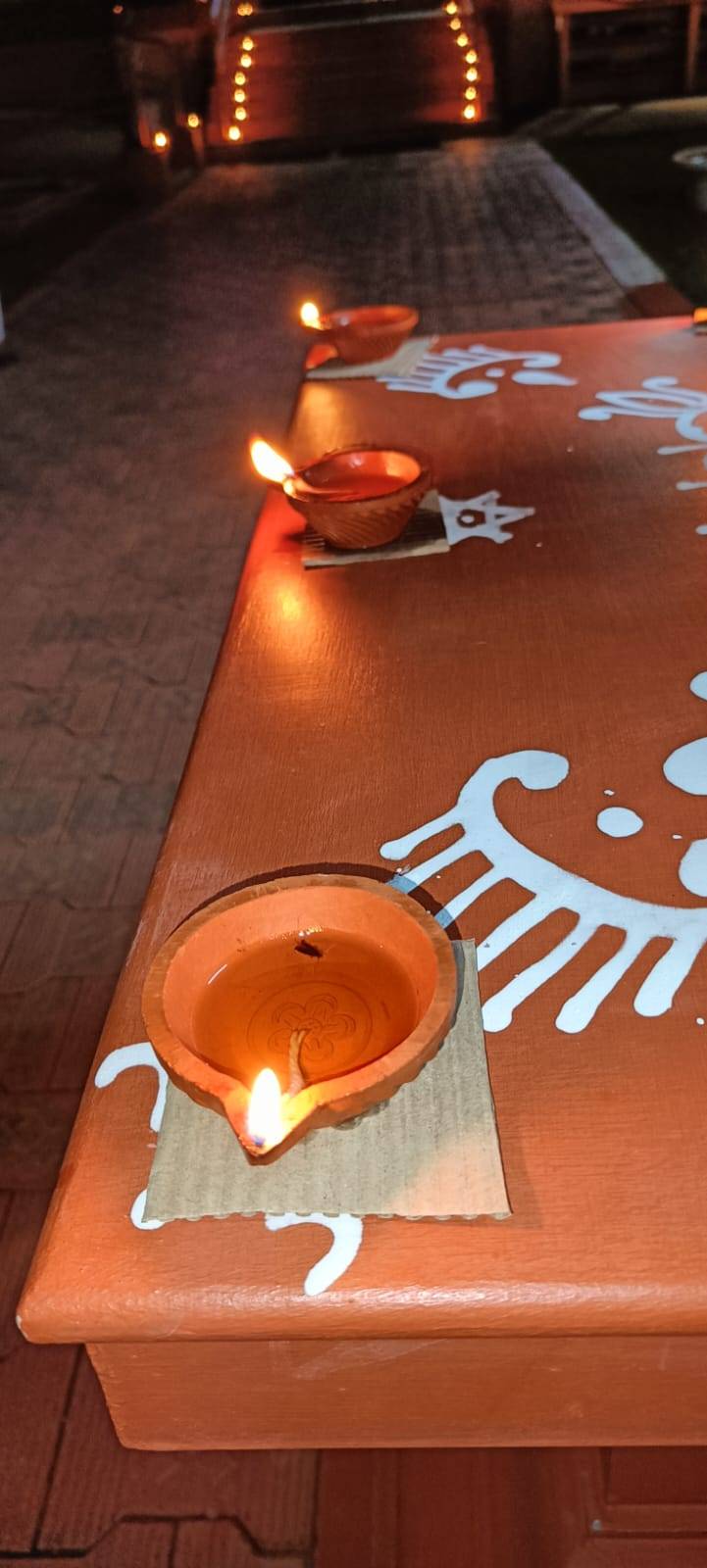
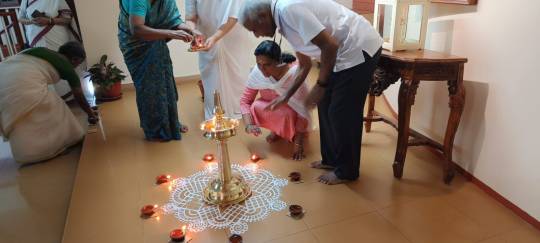

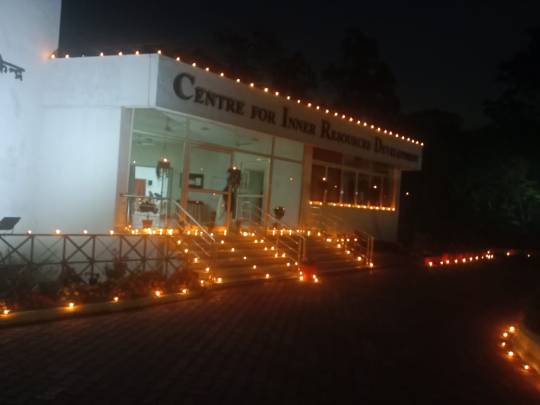


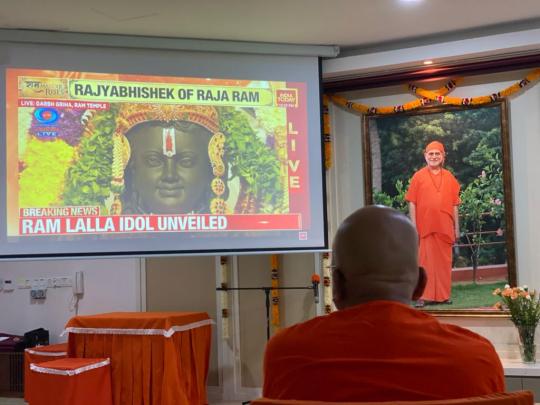





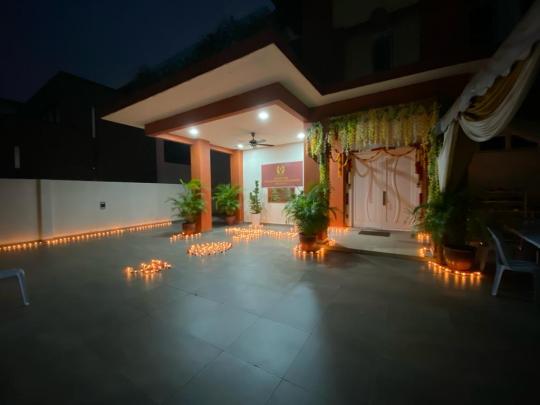


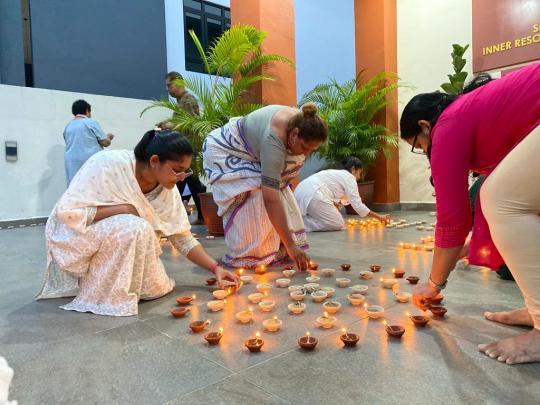
The Pran Pratishtha of the Rama Janmabhoomi Mandir serves as a pivotal milestone in the journey towards cultural freedom of Bharat. Witnessing devotees from across the globe come together to celebrate this occasion is truly beautiful.
Thousands have sacrificed their lives to establish this sacred place, and now, we, the privileged generation, witness the culmination of the 500-year Sri Ram Janmabhumi movement. From the pivotal Supreme Court verdict in 2019 to the Bhumi Puja amidst the challenges of COVID-19, leading to the highly anticipated inauguration on January 22, 2024, it's more than a temple—it's a source of national pride, resilience, and a guiding cultural light.
May this sacred occasion bring us closer to the ideals of Rama Rajya—a realm where wisdom guides, sacrifice prevails, and righteousness flourishes.
At Narayanashrama Tapovanam, Kerala, CIRD Delhi/Jamshedpur and SIRD Malaysia, we celebrated with Rama Bhajans and the radiant glow of lamps. Let's continue to cherish these values and bask in the cultural richness of our heritage.
0 notes
Text
Huge Turnout of Devotees at Ayodhya Ram Temple Following 'Pran Pratishtha'
The highly anticipated opening of the Ram Temple in Ayodhya has drawn massive crowds a day after the grand consecration ceremony, led by Prime Minister Narendra Modi and attended by numerous political figures and celebrities.
Prior to the temple’s public opening, a surge of devotees gathered at the site, with crowds assembling as early as 3 am. The gates will be accessible to the public from 7 am to 11:30 am and again from 2 pm to 7 pm.
The ‘pran pratishtha’ rituals unfolded yesterday, featuring PM Modi paying homage to the Ram Lalla idol. Distinguished guests, including Uttar Pradesh Governor Anandiben Patel, Chief Minister Yogi Adityanath, and RSS chief Mohan Bhagwat, graced the ceremony with their presence.
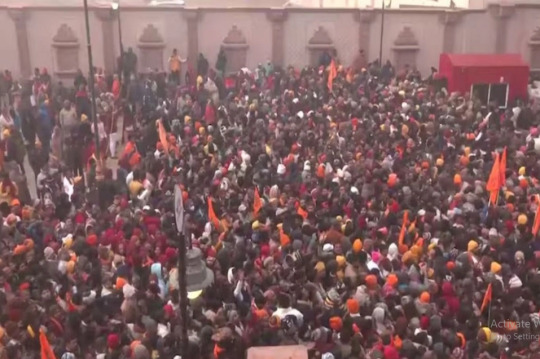
Expressing his sentiments on Twitter, Prime Minister Modi stated, “The extraordinary moment of the consecration of Shri Ram Lalla’s life in Ayodhya Dham is going to leave everyone emotional. It is my great pleasure to be a part of this divine programme. Jai Siya Ram!”
Post the rituals, PM Modi addressed a gathering of approximately 8,000 individuals, comprising seers, Ram Janmabhoomi movement affiliates, and figures from various fields. The Prime Minister also visited Kuber Tila and engaged with workers contributing to the temple’s construction.
While the ceremony was broadcast nationwide, senior BJP leaders like JP Nadda and Union Home Minister Amit Shah opted for live streaming. However, Opposition leaders chose to abstain from the event, leading to political disagreements between the BJP and the Opposition.
Several BJP-governed states declared the day a holiday, encouraging people to witness the ceremony on TV and partake in local temple festivities. Ayodhya’s atmosphere was further heightened by a devotional “Mangal Dhwani,” featuring 50 traditional musical instruments from across the country.
The construction of the Ram Temple concluded a protracted legal battle, culminating in the Supreme Court’s verdict in November 2019 in favor of the temple. Prime Minister Modi, in a national address, heralded the consecration of Ram Lalla’s idol as the dawn of a new era.
Addressing the nation, PM Modi remarked, “I have come before you as you witness the divine consciousness in the temple’s sanctum sanctorum. There’s so much to say, but there’s a lump in my throat. After unprecedented patience, innumerable sacrifices, and penance, our Lord Ram has arrived. I congratulate the country on this occasion.”
PM Modi called for unity, emphasizing that the temple signifies not just triumph but also humility, underscoring India’s maturity in resolving historical disputes. He urged critics to reconsider their perspectives, highlighting that Ram symbolizes energy, not fire, and is a solution, not a dispute.
“The construction of this temple of Ram Lalla is also a symbol of the Indian society’s peace, patience, and mutual harmony. We can see this has not given birth to a fire, but an energy,�� he affirmed in a powerful and emotional post-consecration speech, invoking the spirit of ‘Vasudhaiva Kutumbkam,’ stating that Ram defines the world as a family.
0 notes
Text
Ayodhya's Transformative Journey - Impacts of Recent Developments on Ayodhya Tourism

Ayodhya , a city in the northern Indian state of Uttar Pradesh, has long been at the epicenter of cultural, religious, and historical significance. Recent developments in Ayodhya have not only reshaped the city's landscape but have also had a profound impact on tourism. This article explores the key transformations and their implications for Ayodhya's tourism sector.
Historical Context: Ayodhya, known for being the birthplace of Lord Rama – Ram Janmabhoomi , has been a revered destination for millions of pilgrims and tourists. The city's cultural heritage is deeply intertwined with the Ramayana, one of Hinduism's epic scriptures. The disputed site, formerly occupied by the Babri Masjid, witnessed decades of legal and socio-political controversies until the Supreme Court's landmark verdict in 2019.
Ram Mandir Construction: The Supreme Court ruling paved the way for the construction of a grand Ram Mandir (temple) at the disputed site in Ayodhya. The commencement of the temple's construction marked a historic moment, not only for the local community but for the entire nation. The temple, designed to be an architectural marvel, has become a symbol of religious harmony and national pride.
Impact on Ayodhya Tourism: The construction of the Ram Mandir has attracted a surge in religious tourism. Pilgrims from across the country are making the journey to Ayodhya to witness the progress of the temple and to participate in the religious ceremonies. The city is experiencing an unprecedented influx of devotees, leading to a boost in local businesses catering to their needs.
Recognizing the potential of Ayodhya as a major religious tourism hub, the government has invested heavily in infrastructure development. Improved roads, transportation facilities, and accommodations have enhanced the overall travel experience for tourists. This, in turn, has contributed to Ayodhya's appeal as a tourist-friendly destination.
Ayodhya has witnessed an upswing in cultural festivals and events, celebrating the city's rich heritage. Religious processions, cultural performances, and spiritual discourses are now regular occurrences. These events not only attract tourists interested in religious and cultural experiences but also contribute to the vibrancy of Ayodhya's tourism scene.
The surge in tourism has had a positive impact on Ayodhya's economy. Local businesses, including hotels, restaurants, and souvenir shops, are flourishing. The increased economic activity is not only benefitting the residents but also creating employment opportunities, contributing to the overall development of the region.
The government, in collaboration with tourism boards, is actively promoting Ayodhya as a premier pilgrimage destination. Marketing campaigns, both domestically and internationally, have positioned Ayodhya as a place of spiritual significance and historical importance. This targeted promotion has led to a diversified tourist demographic, including international visitors seeking a unique cultural experience.
The renewed focus on Ayodhya's tourism has led to increased efforts in preserving and restoring the city's heritage sites. Historical monuments, ancient temples, and archaeological sites are being conserved to provide visitors with a comprehensive understanding of Ayodhya's rich past. This not only enhances the tourism experience but also safeguards the city's cultural legacy.
Ayodhya's connectivity with major cities has been improved, making it more accessible to tourists. Upgraded airports, railway stations, and road networks have facilitated smoother travel, encouraging a higher influx of visitors. These improvements have positioned Ayodhya as an easily reachable destination for both domestic and international tourists.
With the growing tourism sector, there is an increasing demand for skilled workforce in hospitality, tourism management, and related fields. The local population is benefiting from training programs and skill development initiatives, equipping them with the expertise to cater to the evolving needs of tourists.
Challenges and Future Considerations: While Ayodhya is experiencing positive transformations, it is essential to acknowledge the challenges and consider future prospects.
As the number of tourists continues to rise, there is a need for sustainable tourism practices. Balancing economic development with environmental and cultural conservation is crucial to ensure that Ayodhya's unique identity is preserved for future generations.
Ongoing maintenance of newly developed infrastructure is imperative to sustain Ayodhya's growth as a tourist destination. Regular upkeep of roads, accommodations, and public spaces is necessary to provide a seamless experience for visitors.
As Ayodhya becomes a global pilgrimage site, it is essential to approach tourism with cultural sensitivity. Balancing the influx of tourists with the sanctity of religious sites is a delicate task that requires thoughtful planning and management.
While religious tourism is at the forefront, there is a need to diversify Ayodhya's tourism offerings. The development of ecotourism, heritage walks, and cultural exchange programs can attract a broader spectrum of visitors, contributing to a more sustainable and resilient tourism industry.
Inclusive development that involves the local community is crucial for the long-term success of Ayodhya's tourism sector. Engaging residents in decision-making processes, promoting responsible tourism, and ensuring equitable distribution of economic benefits are key considerations.
Conclusion: Ayodhya tour packages
0 notes
Text
New Ayodhya Mosque Gets Final Clearance For Construction From City Body
The new Ayodhya mosque construction was delayed for over two years. (representational) Ayodhya: The Ayodhya Development Authority (ADA) has given the final clearance for the construction of Dhannipur mosque in the city as mandated by the Supreme Court in the Babri Masjid-Ram Janmabhoomi verdict. A mosque, a hospital, a research institute, a community kitchen and a library are to be constructed…

View On WordPress
0 notes
Text
Virtual Rallies, PM Modi's Letter, 1K Conferences: BJP's Grand Plans for 1 Year of Modi 2.0
Virtual Rallies, PM Modi’s Letter, 1K Conferences: BJP’s Grand Plans for 1 Year of Modi 2.0
[ad_1]

File photo of Prime Minister Narendra Modi.
The first year of the second term is particularly significant for the party, as it has honoured three top promises made in its manifesto — abrogation of Article 370, the Triple Talaq Act and delivering the Ram Janmabhoomi promise.
IANS New Delhi
Last Updated: May 26, 2020, 12:03 AM IST
May 30 is a red letter day for…
View On WordPress
#aatmanirbhar bharat#abrogation of article 370#BJP#jp nadda#Modi Govt 2.0#Narendra Modi#ram janmabhoomi verdict#Triple Talaq Act
0 notes
Text
Ram Temple in Ayodhya | A Symbol of Faith and Struggle for Hindus
If you are interested in learning more about the Ram temple in Ayodhya, and why it is a symbol of faith and struggle for millions of Hindus, then you should read this article.
The Ram temple in Ayodhya is one of the most sacred and revered places for Hindus around the world. It is believed to be the birthplace of Lord Ram, the seventh incarnation of Lord Vishnu, the supreme deity of Hinduism. Lord Ram is considered to be the ideal king, warrior, son, husband, and father, and his life story is narrated in the epic Ramayana. The Ram temple in Ayodhya is not only a place…

View On WordPress
#aurangzeb o#ayodhya o#babri masjid o#hinduism o#king suheldev o#land purchase controversy#lord ram o#mahmud of ghazni o#o#partition of india o#ram janmabhoomi teerth kshetra trust o#ram temple in ayodhya o#ram temple trust o#ramayana o#salar masud o#supreme court verdict o#vikramaditya o#waqf board
0 notes
Text
Virtual Rallies, PM Modi's Letter, 1K Conferences: BJP's Grand Plans for 1 Year of Modi 2.0
Virtual Rallies, PM Modi’s Letter, 1K Conferences: BJP’s Grand Plans for 1 Year of Modi 2.0
[ad_1]

File photo of Prime Minister Narendra Modi.
The first year of the second term is particularly significant for the party, as it has honoured three top promises made in its manifesto — abrogation of Article 370, the Triple Talaq Act and delivering the Ram Janmabhoomi promise.
IANS New Delhi
Last Updated: May 26, 2020, 12:03 AM IST
May 30 is a red letter day for…
View On WordPress
#aatmanirbhar bharat#abrogation of article 370#BJP#JP Nadda#Modi Govt 2.0#Narendra Modi#ram janmabhoomi verdict#Triple Talaq Act
0 notes
Link
#supreme court judgement on ram mandir#Ayodhya-Verdict-Supreme-Court#Ayodhya-Ram-Janmabhoomi-Babri-Masjid#Supreme-Court-Judgement-on-Ram-Mandir#Ram Janmabhoomi-Movement#Lord-Rama-Temple-in-Ayodhya#Karsevak-Ayodhya ASI-Report-on-Ayodhya
1 note
·
View note
Photo

“No One Demolished Babri”: Sharp Reactions On Twitter On Court Verdict Babri Masjid Demolition Case: BJP leaders LK Advani, MM Joshi and Uma Bharti were acquitted New Delhi: …
#1992 demolition#Ayodhya Ram Mandir#Babri demolition case#Babri Masjid#Babri Masjid demolition#Babri Masjid demolition case#babri masjid demolition case judgement#Babri Masjid Demolition Case Verdict#babri masjid verdict#cbi court judgement#Kalyan Singh#LK Advani#Murli Manohar Joshi#No one demolished Babri#Ram Janmabhoomi#Uma Bharti
0 notes
Text
Ram temple construction in Ayodhya to begin on June 10
Ram temple construction in Ayodhya to begin on June 10
[ad_1]
The construction of the Ram temple in Ayodhya is set to begin on Wednesday when the first bricks will be laid for its foundation, according to a spokesperson for the head of the temple trust.
The event will be marked by prayers to Lord Shiva at the Kuber Tila shrine on the Ram Janmabhoomi site, allocated for the temple in a historic Supreme Court verdict last November.
The rudrabhishekri…
View On WordPress
#ayodhya ram temple#ayodhya verdict#babri masjid demolition#ram janmabhoomi site#ram lalla#ram temple construction#ram temple trust#Supreme Court
0 notes
Photo

In Pics: Ancient idols, Shiv Ling found during Ram Mandir site excavation in Ayodhya Ancient idols, shiv ling, found during Ram Mandir site excavation in Ayodhya General Secretary of the Sri Ram Janmabhoomi Tirth Kshetra Trust Champak Rai on Thursday confirmed that ancient idols along with a shiv ling and carvings were on sandstone were found during the land levelling work at Ram Janmabhoomi site in Ayodhya.
#Ancient#Ayodhya#ayodhya latest news#ayodhya mandir#ayodhya news#ayodhya news today#ayodhya ram mandir#ayodhya ram mandir latest news#ayodhya verdict#babri masjid#excavation#idols#Ling#Mandir#Pics#Ram#Ram Janmabhoomi#ram janmabhoomi trust#ram mandir#ram mandir ayodhya#ram mandir latest news#ram mandir news#Ram Mandir site excavation#ram mandir trust#ram temple ayodhya#Shiv#site
0 notes